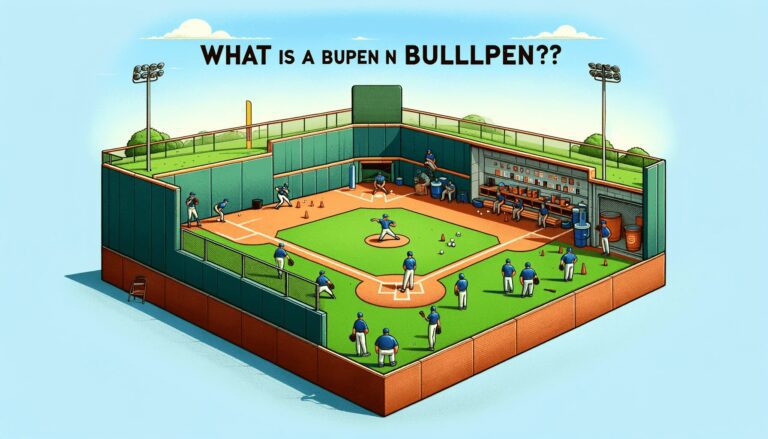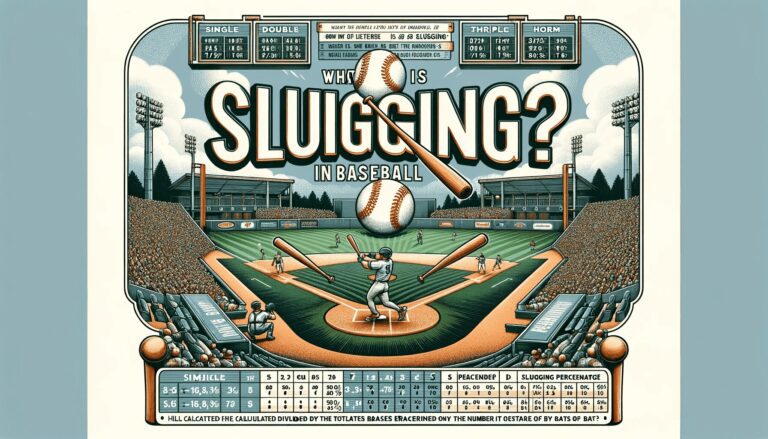What Does WAR Mean in Baseball?
WAR (Wins Above Replacement) is a stat that shows how much value a baseball player adds to their team compared to a replacement-level player. It estimates the number of wins they provide over what a cheap, easy-to-find replacement would provide.
The concept is simple: How many more games would a team win by having this player instead of a readily available minor league or cheap free agent? A WAR of 0 means the player is worth a replacement-level player. Higher is better, with elite players getting a WAR over 5.
WAR combines a player’s offensive and defensive contributions into one number, making it an excellent all-around value metric. By factoring in batting, baserunning, fielding, and positional scarcity, it gives a well-rounded view of a player’s total worth.
Key Takeaways
- WAR is a comprehensive statistic that measures a player’s overall contribution to a team, encompassing offensive, defensive, and baserunning performance.
- The evolution of WAR has shifted baseball’s analytical focus from traditional statistics to advanced metrics, significantly impacting player valuation.
- Calculating WAR involves complex methodologies that differ for position players and pitchers, considering factors such as defensive metrics, park factors, and seasonal constants.
- Interpreting WAR requires understanding its context, including league and positional averages, and recognizing its limitations, such as the quantification of clutch performance.
- WAR is utilized by MLB front offices for roster construction and contract negotiations, as well as by fans for fantasy baseball and betting strategies.
Understanding WAR: A Comprehensive Guide

What is WAR and Why Does it Matter?
Wins Above Replacement, or WAR, is a total-player-value statistic that has gained significant traction in the realm of baseball analytics. It is designed to summarize a player’s total contributions to their team in one comprehensive figure.
By comparing a player’s performance to that of a ‘replacement-level’ player—a hypothetical average player who could be readily available in the minor leagues or on the waiver wire—WAR provides a clear picture of how much value a player adds to their team.
The importance of WAR lies in its ability to encompass all aspects of a player’s game—batting, fielding, baserunning, and pitching for those who do both.
This makes it an invaluable tool for comparing players across different positions and eras, offering a more nuanced understanding of a player’s worth than traditional statistics like batting average or RBIs alone.
Here are some key reasons why WAR matters in baseball:
- It integrates various components of the game into a single metric.
- It allows for comparisons between players with different skill sets.
- It helps in evaluating the overall impact of a player on their team’s success.
As the understanding of baseball evolves, so does the appreciation for comprehensive metrics like WAR, which offer a deeper insight into a player’s true value.
The Components of WAR: Breaking Down the Statistic
WAR, or Wins Above Replacement, is a complex statistic that combines various aspects of a player’s performance into a single comprehensive value.
The goal of WAR is to quantify the total contributions a player makes to their team’s success.
For position players, this includes batting, baserunning, and fielding, while for pitchers, it focuses on their ability to prevent runs.
The components of WAR for position players typically involve:
- Offensive production measured by wOBA (weighted On-Base Average)
- Baserunning abilities assessed by UBR (Ultimate Base Running)
- Defensive prowess quantified by metrics like DRS (Defensive Runs Saved)
Pitchers’ WAR is calculated differently, taking into account:
- Innings pitched
- Run prevention stats like FIP (Fielding Independent Pitching)
- Adjustments for the difficulty of batters faced
Each of these components is weighted and adjusted for context, such as park factors and league averages, to ensure a fair comparison across different playing environments.
Comparing Players with WAR: A Tool for Evaluation
When it comes to evaluating players, Wins Above Replacement (WAR) offers a unique and powerful tool.
By aggregating a player’s total contributions to their team, WAR allows for direct comparisons across different positions and roles.
For instance, a player with a fWAR under 1.0 is considered a replacement-level player, while those with a higher fWAR are increasingly valuable.
- A 1-2 fWAR indicates a decent role player or platoon type.
- A 2-3 fWAR signifies a solid contributor.
- Higher fWAR scores distinguish the good from the great players.
With tools like WAR Graphs and combined WAR leaderboards, fans and analysts can visualize these comparisons and understand the impact of a player’s performance on others.
The 2024 updates to FanGraphs WAR, incorporating advanced metrics, further refine this evaluation process, ensuring that player valuation remains as accurate and insightful as possible.
Read Also: What is RBI in Baseball
The Evolution of WAR in Baseball Analytics

From Traditional Stats to Advanced Metrics
The transition from traditional statistics to advanced metrics in baseball has revolutionized the way we understand the game.
Traditional stats like batting average and RBIs were once the gold standard, but they failed to capture the full impact of a player’s performance.
Advanced metrics, such as WAR, offer a more holistic view by incorporating a variety of factors.
- Traditional Stats: Batting Average (AVG), Runs Batted In (RBI), Home Runs (HR), Wins (W), Earned Run Average (ERA).
- Advanced Metrics: Wins Above Replacement (WAR), On-Base Plus Slugging (OPS), Fielding Independent Pitching (FIP), Ultimate Zone Rating (UZR).
As fans and analysts have become more sophisticated in their understanding of baseball, the demand for metrics that can quantify a player’s overall contribution has grown.
Advanced stats not only provide more layers of context but also help explain how much a player is helping or hurting his team.
Taking these metrics can be daunting at first, but they are essential for a deeper appreciation of the nuances of baseball. You may read the guide on What is WHIP in Baseball
The Impact of WAR on Player Valuation
The Wins Above Replacement (WAR) metric has revolutionized the way players are valued in baseball.
Teams now rely on WAR to make informed decisions about player acquisitions, contracts, and lineup strategies.
This advanced statistic encapsulates a player’s total contribution to their team, making it a powerful tool for comparison and valuation.
- A player’s WAR is compared to a theoretical replacement player, who would have a WAR of zero.
- Players with higher WAR are considered more valuable, as they contribute more wins to their team than the average replacement.
- Contract negotiations often reflect a player’s WAR, with higher values leading to more lucrative deals.
As the understanding of WAR deepens, front offices are increasingly using it to construct rosters that maximize team performance while managing payroll efficiently.
The fWAR, specifically, is a preferred metric for many analysts, as it incorporates a range of data to provide a nuanced view of player value.
2024 FanGraphs WAR Update: What’s New?
The 2024 update to FanGraphs WAR marks a significant shift in the landscape of baseball analytics.
Today’s changes complete the move from UZR to the full suite of Statcast equivalent metrics, enhancing the accuracy and reliability of the WAR calculation.
This transition reflects a broader trend in the industry towards embracing advanced tracking technologies.
Key updates include:
- Integration of Statcast data for defensive metrics.
- Refined calculations for player baserunning and fielding contributions.
- Adjustments to the WAR framework to accommodate new data sources.
These improvements aim to provide a more nuanced understanding of player value, offering fans and professionals alike a deeper insight into the game’s intricate dynamics.
See Also: What is OPS in Baseball
Calculating WAR: The Methodology Explained

Position Player WAR vs. Pitcher WAR
In the realm of baseball analytics, Wins Above Replacement (WAR) is a pivotal metric for comparing the value of position players and pitchers to their peers.
For position players, WAR includes batting, baserunning, and fielding contributions, while for pitchers, it focuses on their ability to prevent runs.
- Position players are evaluated on a variety of offensive and defensive metrics, with a positional adjustment factoring in the relative difficulty of their defensive roles.
- Pitchers’ WAR is calculated differently, considering the number of runs they allow adjusted for the quality of the opposing hitters and the defense behind them.
Understanding the nuances between these two calculations is essential for accurately assessing a player’s overall impact on the game.
The methodology accounts for the unique contributions and challenges each role presents, ensuring a balanced evaluation across all positions.
Understanding the Role of Defensive Metrics
In the realm of baseball analytics, defensive metrics play a crucial role in calculating a player’s WAR.
Metrics such as ‘Defensive Runs Saved’ (DRS) and ‘Ultimate Zone Rating’ (UZR) quantify a player’s defensive prowess by comparing their performance to league averages.
These statistics help to create a more complete picture of a player’s overall contribution to their team:
- DRS measures a player’s defensive performance by estimating how many runs they saved or cost their team compared to an average defender.
- UZR evaluates a player’s ability to get to balls in their zone and the likelihood of them converting those chances into outs.
By incorporating these and other advanced defensive metrics, WAR provides a more nuanced assessment of a player’s value, beyond traditional statistics like errors and fielding percentage.
This allows for a more accurate comparison between players, especially when considering positions with different defensive responsibilities.
Adjustments in WAR: Park Factors and Seasonal Constants
When calculating WAR, it’s crucial to account for the unique characteristics of each ballpark.
Park factors play a significant role in this adjustment, as they measure how much a specific stadium increases or decreases the likelihood of certain outcomes, like home runs or doubles.
For instance, Coors Field is known for being a hitter-friendly park, while others like Tropicana Field are more pitcher-friendly.
Seasonal constants are also applied to ensure that WAR remains comparable across different seasons.
These constants adjust for variations in the run environment, which can fluctuate due to changes in rules, equipment, or playing styles.
By incorporating these adjustments, WAR provides a more accurate reflection of a player’s value, independent of external factors.
- Park factors are derived from the game-by-game data.
- Seasonal constants correct for year-to-year changes in the run environment.
- Both adjustments are essential for comparing players from different eras or teams.
Read Also: What Does SU Mean in Baseball
WAR in Context: How to Interpret the Numbers

League and Positional Averages for WAR
When analyzing Wins Above Replacement (WAR), it’s crucial to consider league and positional averages to fully understand a player’s value.
League averages provide a baseline for comparison, allowing us to discern how a player stacks up against the average performance within their league.
Positional averages are equally important, as they reflect the typical contributions expected from players at each position, which can vary significantly.
- For position players, a WAR above 2.0 generally indicates a solid contributor, while higher figures reflect increasing levels of impact and star quality.
- Pitchers are evaluated similarly, but due to the nature of their role, their WAR calculations differ, taking into account factors unique to pitching.
The FanGraphs WAR Leaderboards are an excellent resource for current standings, showcasing players like Kyle Tucker and Salvador Perez, who have demonstrated significant value to their teams.
By comparing players to these benchmarks, we gain insight into who is performing above or below expectations. You may read also What Does HBP Mean in Baseball
The Significance of Clutch Performance in WAR
Clutch performance in baseball refers to a player’s ability to perform under high-pressure situations, often with the game on the line.
Win Probability Added (WPA) is a key metric that captures these moments, reflecting how individual actions increase or decrease a team’s chances of winning.
In the context of WAR, clutch performance can be a polarizing topic. While WAR aims to quantify a player’s overall contribution, it does not specifically account for the timing of those contributions.
- Players with high clutch performance can significantly influence the outcome of games and, by extension, seasons.
- However, clutch performance is not a stable skill and can vary greatly from year to year.
- Critics argue that including clutch performance in WAR could distort a player’s value, as it may not be indicative of their true talent level.
Understanding the role of clutch performance in WAR is crucial for a comprehensive evaluation of a player.
It highlights the importance of context and situational effectiveness, which are not always reflected in a player’s WAR.
As such, clutch performance should be considered alongside WAR, rather than within it, to appreciate a player’s impact on their team’s success.
Limitations and Misconceptions of WAR
While WAR is a powerful tool for evaluating player value, it is not without its limitations. It’s crucial to understand that WAR is an estimate, not an absolute measure.
The calculation of WAR involves numerous assumptions and approximations, which can lead to variability in the statistics.
Some key limitations and misconceptions include:
- The defensive metrics used in WAR calculations are less reliable than offensive statistics, leading to potential inaccuracies.
- WAR does not account for the context of a player’s performance, such as high-pressure situations or the quality of teammates.
- There is a misconception that a player with a higher WAR is always the better choice; however, the team needs and roster construction can make a lower-WAR player more valuable in certain scenarios.
Understanding these nuances is essential for a balanced view of a player’s contribution to their team.
While WAR can be a guiding metric, it should be used in conjunction with other statistics and scouting reports to make informed decisions.
Read Also: What Does RHP Mean in Baseball
Applying WAR: From Front Offices to Fantasy Leagues

How Teams Use WAR for Roster Construction
In the realm of baseball analytics, Wins Above Replacement (WAR) has become a pivotal tool for front offices when constructing a roster.
By quantifying a player’s overall contribution to the team, WAR allows for a comparison of talent across different positions and skill sets, ensuring a balanced team composition.
- Teams often start by assessing their current roster’s WAR to identify strengths and weaknesses.
- Strategic decisions are then made to acquire, trade, or develop players that can provide the most value in terms of WAR.
- This approach helps in creating a roster that not only excels in individual performance but also contributes to a cohesive winning strategy.
The use of WAR in roster construction is a testament to its versatility and reliability as a roster construction tool.
It guides teams in drafting and trading decisions, aiming for an optimal mix of high-WAR players that can propel the team to success.
The Role of WAR in Contract Negotiations and Trades
In the high-stakes world of MLB, Wins Above Replacement (WAR) has become a pivotal tool during contract negotiations and trades.
Teams meticulously analyze a player’s WAR to gauge their overall contribution and determine their market value.
Here’s how WAR influences these critical decisions:
- Assessing Value: Before entering negotiations, teams evaluate a player’s WAR to establish a baseline for their performance. This helps in comparing players across positions and adjusting offers accordingly.
- Trade Leverage: A player’s WAR can significantly impact trade discussions. Teams use it as leverage, arguing for the player’s potential impact on winning games. For instance, when teams were interested in trading for J.D. Davis, his desire to be a starter and the presence of established third basemen elsewhere were key considerations.
- Future Projections: WAR isn’t just about past performance; it’s also used to project future contributions. This forward-looking approach is crucial in determining the length and value of contracts.
Understanding a player’s WAR is essential for front offices aiming to build a competitive roster while managing financial constraints.
It’s a balance of recognizing talent and anticipating future success, all distilled into a single, powerful statistic.
Leveraging WAR for Fantasy Baseball Success
In the realm of fantasy baseball, Wins Above Replacement (WAR) has become an indispensable tool for savvy managers.
By quantifying a player’s overall contribution to their team, WAR allows fantasy players to make informed decisions when drafting, trading, or claiming players off waivers.
- Drafting Strategy: Prioritize players with high WAR values, as they are likely to contribute across multiple statistical categories.
- Trade Analysis: Use WAR to evaluate the fairness of trade offers, ensuring you receive comparable value in return.
- Waiver Wire: Monitor the WAR of undervalued players who may be available for pickup, often leading to a competitive edge.
Understanding the nuances of WAR can lead to a significant advantage in fantasy leagues. By integrating WAR into your strategy, you can better assess player value and performance, ultimately aiming for that championship title.
See Also: What Does DFA Mean in Baseball
Conclusion
To sum up, WAR stands for Wins Above Replacement. It’s a stat that shows how much better a player is compared to a replacement-level player from the minor leagues. The higher the WAR, the more valuable the player is to their team.
WAR takes into account hitting, fielding, and pitching to give an overall picture of a player’s contributions.
It’s a handy way to compare players across different positions and see who is really standing out.
While WAR isn’t perfect, it gives fans and teams a simple number to understand and appreciate a player’s total value on the field.







